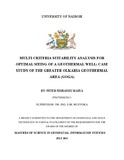| dc.contributor.author | Maina, Peter Ndirangu | |
| dc.date.accessioned | 2013-07-30T12:03:57Z | |
| dc.date.available | 2013-07-30T12:03:57Z | |
| dc.date.issued | 2013 | |
| dc.identifier.citation | A project submitted to the department of geospatial and space technology in partial fulfjllment of the requirements for the award of the degree of: masters of science in geospatial information systems | en |
| dc.identifier.uri | http://erepository.uonbi.ac.ke:8080/xmlui/handle/123456789/52541 | |
| dc.description.abstract | In this study, the focus was on the applications of Geographical Information Systems (GIS) as a
decision support system in geothermal resource exploration in the Greater Olkaria Geothermal
Area (GaGA).
The main objective of the project was to demonstrate how GIS can be applied in Geothermal
well siting, making use of data sets from three key Geo-scientific fields- geological, geochemical
and geophysical disciplines. Specific objectives included the determination of key factors in each
of the geo-scientific fields that will be used in generation of suitability maps for each of the three
fields. The three individual suitability maps were then integrated in ArcGIS 10.1 and used to
generate the final geothermal well-site suitability map.
The methodology employed included determination of various factors for each of the three
involved Geo-Scientific fields and a criterion for suitability was determined for each of the
factors. Results of all factors for each of the disciplines were overlaid and a suitability map for
each of the three fields was generated. The final Suitability map for geothermal well siting was
obtained from the results of integration of the three suitability maps. The results of the final
suitability map was a classification of the study area into three primary regions namely; most
suitable area, moderately suitable area and the least suitable area.
The results of the study were compared with results obtained by current exploration methods
employed by KenGen at Olkaria. On numerous occasions, current methods have led to siting and
consequent drilling of dry wells. The studied approach aimed at avoiding location and drilling of
dry wells as it was inclusive of a more thorough approach at exploration stage as opposed to the
current methods employed by Kengen.
The study recommends adoption of this criteria by the management at KenGen as it guarantees
accuracy and an easier decision making process for sustainable location of well sites by
effectively making use of GIS as decision support system. | en |
| dc.language.iso | en | en |
| dc.title | Multi-criteria suitability analysis for optimal siting of a geothermal well: case study of the greater olkaria geothermal area (goga) | en |
| dc.type | Thesis | en |
| local.publisher | Geospatial and Space Technology, University of Nairobi | en |

